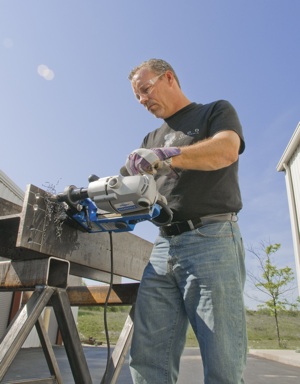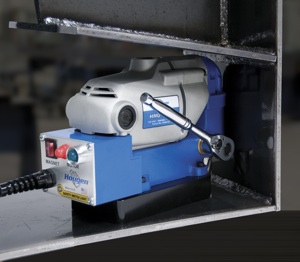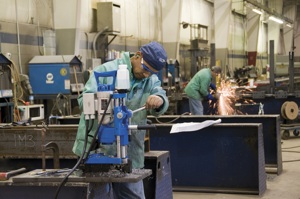Exclusive: Getting Maximum Productivity from Portable Magnetic Drills
Hougen discusses types of drills and cutters and how to use them most effectively.
When you need to make holes and cannot take the work to a machine, a portable magnetic drill is usually the tool of choice. But it all starts with using the right tools for the project. Today, fabricators and contractors have the choice of a wide variety of types, sizes and features of magnetic drills and annular cutters for on-site holemaking.
Although basic portable magnetic drills are the most popular and quite versatile, they may not be big enough, powerful enough, or perhaps small enough to handle a particular job. For example if you are drilling in hard to reach or confined spaces you need a drill that will fit those spaces. However, if you are drilling extremely hard, rusty, scaly or painted material you also need to choose the proper cutters. We are not going to cover every situation, but we hope that this article will give you some ideas and hopefully answer some questions. But in the end, no matter what the job, if you increase productivity, you increase profitability. And that is what this is all about.
 Types of equipment available today
Types of equipment available today
There are various sizes and types of portable magnetic drills available today…too many to list so we have grouped them in general categories.
The most basic are standard manual-feed portable magnetic drills that use annular cutters. Quite popular, they are offered in a variety of sizes, speeds, horsepower ratings and coolant system options. Most of these units use a three-handle feed with a slide and gib system for moving the motor, arbor and cutter together. Standard features as well as costs vary from one manufacturer to another, but for heavy-duty, highly repetitive holemaking jobs a low price magnetic drill can result in the need to replace it before even one project is complete.
One of the newer offerings in magnetic drills are variable-speed quill feed models. They are lightweight, easy to use, have a large drilling capacity and do not require gib and slide adjustments. Their constant profile allows them to fit in tight, confined spaces where standard drills may not operate. Quill feeds provides fast, smooth feeds throughout the cut, even in deep-hole drilling. Optional pressurized coolant delivery systems are extremely valuable in this situation. Variable speeds can increase tool life and favor use of carbide cutters which require higher RPMs than standard annular cutters.
When faced with the problem of drilling in confined spaces less than 8 inches in height, the new, ‘mini’ 90-degree, low profile drills offer a good solution. They have a single feed handle, not the standard three-handle feeds like most magnetic drills. They also have an excellent cutter size range and because they have a quill feed, just the cutter moves, so they will operate in any place they can fit. Their light weight makes them an ideal choice when the job requires carrying the drill up a ladder or a lift and they are also extremely handy on rehab jobs.
 When the job requires repetitive holes then consideration should be given to power-feed models. They provide consistent holemaking with less operator fatigue plus productivity can be improved because one operator can operate two or more drills at the same time. While one unit is cutting a second can be set up. Look for drills that electronically optimize the feed rate for greater tool life and higher quality holes.
When the job requires repetitive holes then consideration should be given to power-feed models. They provide consistent holemaking with less operator fatigue plus productivity can be improved because one operator can operate two or more drills at the same time. While one unit is cutting a second can be set up. Look for drills that electronically optimize the feed rate for greater tool life and higher quality holes.
When drilling in vertical or horizontal positions swivel base drills should be given strong consideration. However, look carefully at ergonomics because some units will require adjustment tools to use the swivel and that defeats their purpose. A swivel base drill allows you to roughly position the drill and activate the magnet. Then, by releasing the swivel mechanism, the drill pilot can be precisely positioned over the hole’s center point and locked down. This feature will speed up alignment for precision holes. And this is a lot faster than trying to hold the entire weight of the drill in the proper alignment before activating the magnet. Other attributes of swivel base drills are they can be used in tight quarters and also easily get out over another piece of steel.
Some of the less popular styles include permanent magnet drills which are available for special applications where electric power is unavailable, however, they are extremely heavy and have limited holding power. Some permanent magnet drills have pneumatic motors for use in explosive atmospheres where sparks can be catastrophic. Another type of drill uses a hydraulic motor, which provides higher horsepower in a smaller package and is offered with either an electro or permanent magnet. The disadvantage here is that hydraulic power is not always available.
Some manufacturers of magnetic drills have solved unusual holemaking problems for customers by modifying existing drills for specific applications. For example, building a unit that drills from the bottom up or developing special fixturing for deep-hole drilling. For special applications always consult a magnetic drill manufacturer.
In summary, choosing the right portable magnetic drill can increase productivity, improve ergonomics, reduce costs and produce higher quality holes.
 Setting up the job
Setting up the job
Setting up the job is basically the same no matter what type of magnetic drill you use. Here are some helpful hints to improve your drill’s performance and cutter life.
Obviously the material base to be used must be ferrous metal for the electro magnet to properly work. The material type dictates the type and grade of the cutting tool to be used. We will go into further detail on this in the operation section.
The first step is to make sure you have a clean, flat, smooth work surface that is free of chips. Make sure the bottom of the magnet is also clean. Any foreign matter including chips under the magnet could rock it and decrease its holding power resulting in the drill rotating or shutting down because the safety mechanism was activated. If the surface is not perfectly flat, such as an I-beam that has a crown, you need to make sure the magnet is not affected. Placing the magnet to one side and not over the crown will give better results. The use of a swivel base magnetic drill might help in this situation. If the surface is heavily rusted or covered with paint, especially epoxy, the magnet may not obtain good holding power. Special care must be taken to insure proper magnet adhesion. The proper, well-sharpened cutting tool may help in this situation because it may put less stress on the magnet while making the hole. Or this may be a good time to step up to cobalt or carbide cutting tools.
Using a safety chain or strap is critical in the event of a loss of power or the drill safety circuitry shutting itself down because it will ensure the drill does not fall or injure the operator. Several years ago there was a contractor rehabbing a bridge in New York. The workers were not using safety chains and when there was a power failure, a majority of the 40 drills being used on the project ended up in the East River. A true story and an expensive oversight. Using a combination of good common sense and information from the operator’s manual will go a long way in the proper and safe use of your drills.
 Coolant extends cutter life
Coolant extends cutter life
Proper use of coolant is essential to cutting tool life and good drill performance.
Many magnetic drills come equipped with gravity feed coolant systems while others offer arbors with internal coolant reservoirs. Coolant for annular cutters should have high lubricity-low viscosity. If a drill is not equipped with a through-the-tool coolant system, coolant should never be squirted on the cutter because it will just spin off during drilling instead of getting to the cutting teeth where it is needed. In this instance, a good stick lube placed on the cutting teeth will do the job. Stick lube is a waxy substance that will adhere to the teeth of the cutting tool and will last for one hole. It should always be used when drilling in horizontal or overhead positions. For deep hole drilling a pressurized coolant system will perform the best and provide better tool life. Running cutters dry will build up excessive heat, shorten tool life and possibly result in an inferior hole.
Ten Operation tips
We chose to list the ten most common problems or areas of concern we get calls about to our customer service department. Interestingly, we found that many of these problems are the result of operators ignoring them.
1. A two-setscrew system to secure the cutter assures rigidity of the cutting tool resulting in longer tool life and better holes compared to tool-less cutter holding systems. However, some users may value the speed of tool change over extended tool life.
2. Always use a pilot because it helps line up the cutter to the hole’s center point, and more importantly, helps the coolant flow to the cutting teeth. It also aids in ejecting the slug at the end of the cut.
3. Always use the right cutter for the application. Annular cutters are material specific and using the right cutter will result in optimal tool life as well as the achieving the greatest productivity and hole quality. Although many tool manufacturers supply data on what cutter types to use with specific material, when in doubt, consult with the cutting tool manufacturer. In some cases they may suggest a custom tool such as an extended reach cutter for deep-hole drilling.
4. Carbide cutters offer several benefits such as longer tool life and drilling in extremely hard material. However, they must be run two to three times faster than ordinary M2 cutters. If using an older model drill, chances are it will not generate the proper PRMs to gain the benefits of carbide.
5. When drilling two or more stacked plates or a bridge structure that has double- layered steel always specify a cutter with ‘stack cut’ tooth geometry. Using a standard annular cutter will require stopping the drill after each plate is cut to remove the slug. Stack cut cutters cut inside/out rather than outside/in so the slug doesn’t get caught. Drilling the same hole in several plates using stack cut cutters will increase productivity rates.
6. A major cause of broken or prematurely dull annular cutters is a slow feed rate. A firm, aggressive, steady feed pressure throughout the cut, where you can hear the motor work but not overly labored, will result in a good hole and long tool life provided coolant and proper cutter selection are also employed. A good feed rate will also result in a healthy chip coming up out of the flute keeping the cutting teeth free to do their job. When the hole is finished there should be a good “birds nest” on the cutter. A slow feed rate will result in a thin chip that can start to break up and pack up in the flutes. This will either slow down or stop the cutting action and possibly break the cutter. A dull cutter will also have a tendency to lift the magnet, which can lead to a broken cutter. If the cutting action is diminished, resharpen or replace the cutter. Pecking the cutter will also break up the chips instead of working them up the flutes causing the same problems.
7. Some users will try to “horse” the cutter through the material by applying too much pressure. They think they are cutting faster when in actuality they are not because as they load up the machine, the RPMs decline and metal removal rates and RPMs go hand in hand. The slower the cutter turns the more the metal removal rate diminishes. Listen to the motor and let the machine and cutting tool do the work.
8. If stainless steel is being cut three things need to happen. First a vacuum pad needs to be employed or a piece of ferrous metal must be clamped to the surface for the magnet to hold. Second, make sure the cutter selection is properly matched for the hardness of the material. This may be a good place to use carbide. Then when drilling, an aggressive feed rate is essential because stainless steel will quickly work harden if you don’t stay ahead of it with the cutting action.
9. Always make sure the slug has ejected at the end of the cut. Drills with a positive slug ejection feature will accomplish this automatically. Spring ejection systems do work but are much less reliable. For example, the cutting action generates heat resulting in the slug slightly growing and possibly getting caught in the tool. Removal can be time consuming and there is also a risk of breaking the cutter while trying to remove the slug. And remember, the edge of a slug is very sharp so handle with care. Positive ejection displaces the slug upon completion of the hole. It is a little more expensive but well worth the cost when trying to meet production schedules.
10. Always clear away chips and excessive coolant from the work surface after completing a hole, particularly when making additional holes. Also check the coolant level, cutter condition and make sure the slug is ejected.
 Good maintenance can extend drill and tool life.
Good maintenance can extend drill and tool life.
The old adage, “When all else fails, read the instructions” applies here. A magnetic drill’s operator’s manual will no doubt have many good maintenance procedures listed. However, there are also some good common sense items that should be continuously followed. We have talked about many of them in this article, which are common every day practices.
If your drill has a slide and gib system it needs to be periodically adjusted and lubricated. The rigid arbor system should periodically be checked for excessive run out, making sure parts are not worn or the arbor sloppy, which can lead to premature tool failure or inconsistent holes. Quill feed drills usually require no adjustments.
A properly working coolant system is essential to tool life and should be checked for coolant flow and possible obstructions.
It is also a good practice to periodically check if the safety system is working properly. Should a drill’s magnet break loose while cutting and the safety system is faulty serious operator injury could happen. Some operators have been known to attempt to override a drill’s safety system, which is not only dangerous but will usually void a warranty.
The magnet’s surface can wear and lose flatness from sliding around during everyday operation. The front and back can begin to curve or chips can get embedded so it may periodically need to be surface ground to restore flatness.
Other items to check are more obvious such as power cord and electrical switch conditions.
Accessories for increased versatility
A magnetic drill can become a virtual portable machine shop by employing readily available accessories such as a twist drill chuck, countersink, tapping, twist drill adapter kit and adapters for drilling pipe. There also various spindle adapters for special tooling. A vacuum pad can be employed for drilling on stainless steel, diamond plate and uneven surfaces up to 3mm deep provided compressed air is available. The pressurized coolant system we spoke about earlier is also considered an accessory. The true advantage of these accessories is not only convenience but they can be a necessity when working in the field.
In conclusion
Features, options and cost all vary by manufacturer. This has been a look at some of the latest technology available in portable magnetic drills as well as a list of reminders on their operation. When faced with any job it is always a good idea to conduct a pre-job assessment then take a good look at what equipment you have on hand. If some of your equipment is outdated, improve your productivity by talking to your tool distributor.
If you are up to date on your equipment, a properly operated, well maintained and accessorized portable magnetic drill can go a long way in helping to meet production schedules, improving productivity and maintaining a positive bottom line. CS
Author Jeff Miller is Manager of Engineering for Hougen Manufacturing, Inc., Swartz Creek, MI. He can be contacted at 800-426-7818. For more information on Hougen and its products visit: www.hougen.com
















